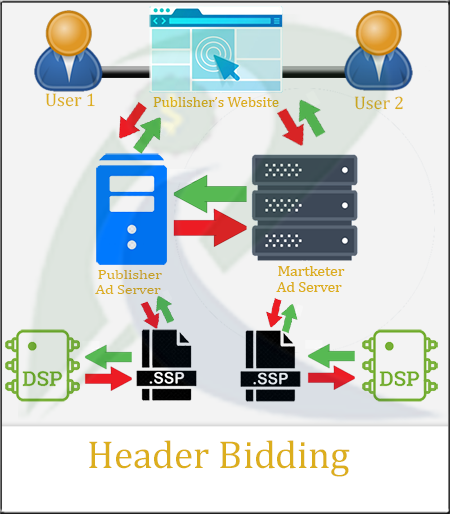Hi, guys in this post we will disscuss what is header bidding? For most publishers, these programmatic ads are not less than aliens; however, little knowledge is always necessary. Header bidding, also known as Pre-bid – is the most advanced technology in Adtech, where publishers meet The Highest Possible Income by offering their ad inventory to several Ad Exchanges simultaneously.
It facilitates publishers to offer ad inventories out to various SSPs or Ad Exchanges simultaneously. It additionally gives publishers much more power over the cycle, including to who they offer it.

Before Header Bidding:
Header bidding wasn’t something that shook the digital advertisement because advertisers were already bidding through Google RTB. Header bidding simply involves an auction between multiple Ad Exchanges.
Before programmatic ads, direct-sold was the most trusted method – since it was considered the highest priority in the ad server. Direct sold were lacking on so many points. It involved manual efforts that created doubt about its efficiency and transparency.
Direct sold is a method that works with a waterfall system. That means it is not sure whether the advertiser’s money is worth it or not.
The actual issue with the waterfall or daisy-chain framework is the value an ad impression sells for doesn’t mirror its genuine worth. The unsold inventory offers the highest level of an ad exchange. Normally dictated by size, as opposed to the most elevated bidder. Suppose nobody in this gathering puts it all on the line. It passes down to the subsequent tier until someone bids for it.
Somebody in the following tier-down might be ready to address a greater expense. Ultimately, they never found an opportunity to bid for their needed ad inventory. Such advertisers leave investment on the table for publishers with heavy hearts.
Mechanism Of Header Bidding:
Header bidding means that only defined demand sources are involved in the auction simultaneously, and publishers can handle which sources can take part in the process.
Header bidding is executed through the JavaScript library.
The header is an HTML component on a publisher’s webpage that stores initial substance (like; logo, symbol, authorship data) or a set of route links. It is a string of code invisible to the end user.
However, auction request generates by the user’s private browser. Simply a string of code embedded in the publisher’s website header. This code pings numerous exchanges and DSPs at the same time.
After that, the publisher’s SSP or Ad server selects the highest cost at the auction.
Header bidding can execute either through the customer side or, if necessary, a server-side wrapper that helps to release application resources and positively sway the speed of application/page stacking.
How Does It Benefit Publishers?
Publishers can simply raise their revenue within no time by increasing competition for their ad inventory. Since it is an automatic system, no ad server adjustment requires until they add a new partner to the auction list. Publishers are also free from managing demands from priorities and demand partners. It is also the most efficient system in the history of digital advertisement.
How Does It Benefit Advertisers?
The biggest benefit for advertisers is transparency and ad viewability. Before header bidding, advertisers were limited to buying ad inventory within the exchange and were paying the same amount for repeated ads to users, but now advertisers can bid through any desired ad exchange for the same ad inventory and can bid for 1st ad look and repeated respectively.
Now advertisers are not just paying for ad space, but they are paying for the value additions header bidding has opened for adtech.
Where It Lacks?
Header bidding is the cause of render-blocking, which cannot solve by applying asynchronous loading – since it will increase load time. It can solve by server-to-server bidding. That requires good developer skills and a good server, which is costly.
The high yield is short-term; if advertisers do not get a good result, they’ll stop bidding for your website. It is also a myth that header bidding serves ads along with quality. Header bidding only decides which ad should be performed regardless of its quality and placement.
Conclusion:
Being an experienced digital marketing company – we have analyzed that the future of digital marketing is majorly dependent on Exchange bidding than Header bidding.
Or you can say it’s 70% dependent on Exchange bidding and 30% on Header bidding. Because Prebid can be inherited with Exchange Bidding to avail low latency bidding, it requires developing skills and server expenses to do so.